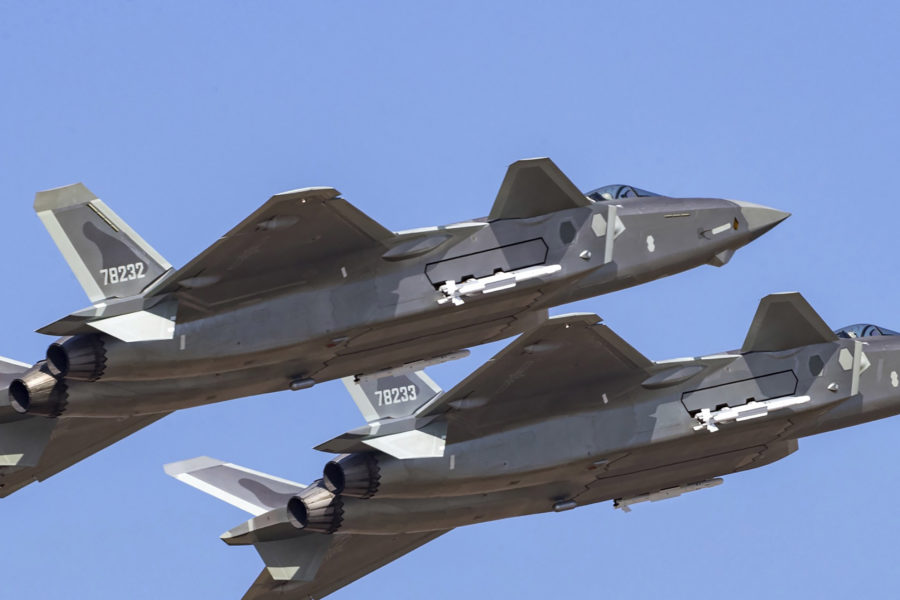The Chinese air force is developing new stealth aircraft and expanding the weapons-carrying capacity of its J-20 stealth fighter, the Pentagon said in its annual report on Chinese military power, issued Nov. 3. The Pentagon said U.S. advantages in the air domain are “eroding” as China’s air and naval air forces shift from a defensive mode to power projection and long-range attack.
The People’s Liberation Army Air Force and Navy (the PLAAF and PLAN) together operate the largest air forces in the Indo-Pacific region and “the third-largest in the world,” with 2,800 aircraft—not including trainers or unmanned aerial systems—of which 2,250 are combat-coded bombers, fighters, and multi-role airplanes, according to “Military and Security Developments Involving the People’s Republic of China, 2021.”
Quoting China’s own internal defense white paper from 2019, the Pentagon said the air forces are transitioning from strictly air defense to “offensive and defensive operations,” toward building a “strategic” air force capable of projecting power at long range.
“The PLAAF is rapidly catching up to Western air forces,” the report said. “This trend is gradually eroding longstanding and significant U.S. military technical advantages” relative to the PRC “in the air domain.”
The Pentagon revealed that in addition to China’s J-20 Mighty Dragon and FC-31 stealth fighters, as well as a “strategic” stealth bomber, China is developing “new medium- and long-range stealth bombers to strike regional and global targets.”
The strategic stealth bomber, likely called the H-20, employs “many fifth-generation technologies,” having a range of 8,500 kilometers and a payload of “at least 10 metric tons.” It will have a nuclear mission in addition to filling conventional roles, and the Pentagon estimated it will take “more than a decade to develop this advanced type of bomber.” However, the DOD has consistently underestimated China’s ability to rapidly field new aircraft over the last two decades.
The near-term goal of the PLAAF is to become a more effective and capable force “proficient at joint operations.” The Chinese air force has reorganized itself into multi-role brigades and has disbanded its fighter and fighter-bomber divisions.
The Pentagon reiterated its previous report’s assertion that, within the next several years, the PLAAF will transition from obsolescence to “a majority fourth-generation force.”
The marquee aircraft of the PLAAF is the J-20, which the Pentagon said has been fielded in “limited numbers,” without being specific, although recent open-source estimates place it around 150 airplanes. China continues to develop the FC-31 Gyrfalcon two-engined lookalike of the American F-35 either for export or as “a future naval fighter for the PLAN’s next class of aircraft carriers.” China has taken delivery of all 24 Su-35 advanced Flanker aircraft it bought from Russia and continues to develop its own J-15 version.
Upgrades of the J-20 are already underway, including “increasing the number of [air-to-air missiles] the fighter can carry in its low-observable configuration” as well as “installing thrust-vectoring engine nozzles, and adding supercruise capability” by installing indigenous WS-15 engines. Early models of the J-20 relied on Russian engines, and China watchers are divided over whether PLAAF’s engine suppliers have overcome production problems with high-performance fighter engines.
The report does not include developments in China’s military since 2020. Just in October 2021, China allowed images to circulate of a two-seat J-20 taxiing—suggesting a manned/unmanned teaming role for the backseater—and a refined version of the FC-31 in flight. The FC-31 images showed a catapult launch bar on the nose landing gear and a wing-fold mechanism on the wings, clearly indicating the jet is headed for carrier service.
China’s nascent strategic bomber capability is embodied in an upgraded H-6N, a derivative of the Russian Tu-16 “Badger,” which boasts an air refueling capability for longer range and recessed carrying space on the fuselage for an “air-launched ballistic missile.” Other variants of the H-6 are being upgraded for long-range attacks of targets in the “second island chain” perimeter of China in the Pacific.
Other new aircraft in China’s air force include the GX-11, a variant of the Y-9, used for jamming and electronic countermeasures, “designed to disrupt an adversary’s battlespace awareness at long ranges.” In addition to the Russian Il-78 Midas aerial tanker, China has modified some H-6U bombers into the tanker role. A tanker version of China’s Y-20 transport, which resembles the American C-17, is also in development. While the report says deliveries of the Y-20 are underway, it did not give numbers.
Another new aircraft is the KJ-500 airborne early warning and control aircraft, an advance over the KJ-2000 and KJ-200 variants. This AWACS-like airplane with a circular radome housing active electronically scanned array radars, is also believed to be used for networking various parts of the joint Chinese forces.
The Pentagon drew on showcased systems in the People’s Republic of China’s 70th Anniversary parade in 2019 to describe many of China’s unmanned aircraft, noting the new Gongji-11 stealthy flying-wing aircraft, believed to be capable of carrying weapons and a host of systems meant to conduct intelligence, surveillance, and reconnaissance.
In addition, the report called out the “large dual-engine TW356 transport UAV that suspends a large cargo pod between the two large engine nacelles” as a noteworthy development. The Xianglong “joined-wing high altitude” unmanned aircraft, a rough analog to the Global Hawk, is being deployed to airfields in Western China and on Hainan Island. The report also noted a “rocket-powered,” high-speed UAV called the Wuzhen-8.
Unlike previous reports, the latest version did not describe PLAAF and PLAN air-to-air missiles. China’s PL-15, analogous to the American AIM-120 Advanced Medium-Range Air-to-Air Missile (AMRAAM), has longer range than the U.S. missile.
